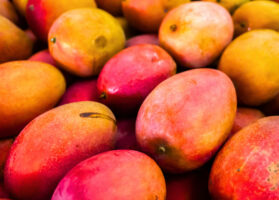A look ahead at the Mexican mango season
Overview of mangos from Mexico in the U.S. market, complemented by charts from Agronometrics. Original published on December 15, 2022.
The Mexican mango season looks to be starting the third week of January. “Right around January 20th is our expected starting pack date for Ataulfos which are always the first to start. Tommy Atkins typically starts about a month later for most but we have some earlier micro-regions so we’ll start around February 10 or 12,” says Nissa Pierson of Crespo Organic.

Source: USDA Market News via Agronometrics.
(Agronometrics users can view this chart with live updates here)
While it’s still early, the weather for the Mexican bloom season was good. “The first and second blooms in Oaxaca and Chiapas were really good and the first bloom’s fruit set was really good. That generally points to really good yields,” she says.
However, in the past few weeks significant rains have hit the region and in turn, that has affected the second bloom. “The Crespo brothers are there now assessing, trying to see which of those are turning into fruit set, identifying any possible gaps,” adds Pierson, adding those rains though are likely leading to bigger fruit than in previous seasons. “The yields could be less predictable if the blooms were washed off in the rain.” She also adds that every January right before harvest, a weather pattern usually hits Mexico and sometimes the wind is so bad, it’s strong enough at times to take mangoes off the trees. “Once that moves through, we’ll be in a better stage of understanding what will happen.”
Other varieties
Following the start of the Ataulfos, Crespo will also have Tommy Atkins and its Indian Mallika mangoes and Thai mangoes starting around mid-February.
While Peru will still be shipping mangoes at that time, Ataulfos will be coming out of Mexico and they have their own demand patterns. “Mangoes have stronger demand in spring and summer so as our Mexican crop grows voluminously each month, the North American appetite for mangoes grows with it,” says Pierson.
It’s possible pricing may be pressured by the increasing production coming out of Peru. “Prices can be pretty low for Peruvian fruit, which can sometimes even have quality problems. We are at the mercy a bit in terms of what people are paying for Peruvian mangoes,” says Pierson. “But our pricing is fairly stable and the Mexican mango fairly coveted. Pricing itself is higher for the southern regions than it is in the Northern regions in the summertime. Costs have been high in the last couple of years in general yet consumer demand continues to be high despite the increased costs/pricing. We will find a way to make it work.”
The News in Charts is a collection of stories from the industry complemented by charts from Agronometrics to help better tell their story.
Access the original article with this (Link)






